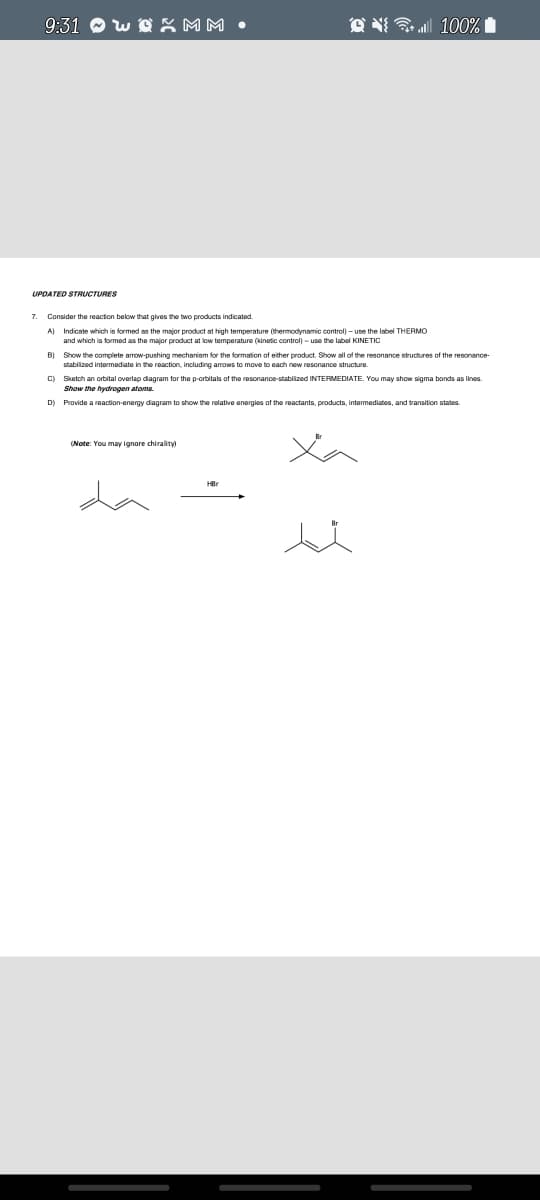UPDATED STRUCTURES 7. Consider the reacion below that gives the two products indicated. A) Indicate which is formed as the major product at high temperature (thermodynamic control) - use the label THERMO and which is formed as the major product at low temperature (kinetic control) - use the label KINETIC B) Show the complete arrow-pushing mechanism for the formation of either product. Show all of the resonance structures of the resonance- stabilized intermediate in the reaction, including amows to move to each new resonance structure. C) Sketch an orbital overlap diagram for the p-orbitals of the resonance-stabilized INTERMEDIATE. You may show sigma bonds as lines. Show the hydrogen atoms. D) Provide a reaction-energy diagram to show the relative energies ot the reactants, products, intermediates, and transition states. (Note: You may ignore chirality) HBr
UPDATED STRUCTURES 7. Consider the reacion below that gives the two products indicated. A) Indicate which is formed as the major product at high temperature (thermodynamic control) - use the label THERMO and which is formed as the major product at low temperature (kinetic control) - use the label KINETIC B) Show the complete arrow-pushing mechanism for the formation of either product. Show all of the resonance structures of the resonance- stabilized intermediate in the reaction, including amows to move to each new resonance structure. C) Sketch an orbital overlap diagram for the p-orbitals of the resonance-stabilized INTERMEDIATE. You may show sigma bonds as lines. Show the hydrogen atoms. D) Provide a reaction-energy diagram to show the relative energies ot the reactants, products, intermediates, and transition states. (Note: You may ignore chirality) HBr
Chemistry
10th Edition
ISBN:9781305957404
Author:Steven S. Zumdahl, Susan A. Zumdahl, Donald J. DeCoste
Publisher:Steven S. Zumdahl, Susan A. Zumdahl, Donald J. DeCoste
Chapter1: Chemical Foundations
Section: Chapter Questions
Problem 1RQ: Define and explain the differences between the following terms. a. law and theory b. theory and...
Related questions
Question
A.B.C.D please!

Transcribed Image Text:9:31 O w D X MM •
O N a 100%
UPDATED STRUCTURES
7. Consider the reacion below that gives the two products indicated.
A) Indicate which is formed as the major product at high temperature (thermodynamic control) – use the label THERMO
and which is formed as the major product at low temperature (kinetic control) - use the label KINETIC
B)
Show the complete arrow-pushing mechanism for the formation of either product. Show all of the resonance structures of the resonance-
stabilized intermediate in the reaction, including amows to move to each new resonance structure.
C) Sketch an orbital overlap diagram for the p-orbitals of the resonance-stabilized INTERMEDIATE. You may show sigma bonds as lines.
Show the hydrogen atoms.
D) Provide a reaction-energy diagram to show the relative energies of the reactants, products, intermediates, and transition states.
(Note: You may ignore chirality)
Expert Solution
This question has been solved!
Explore an expertly crafted, step-by-step solution for a thorough understanding of key concepts.
Step by step
Solved in 4 steps with 2 images

Recommended textbooks for you

Chemistry
Chemistry
ISBN:
9781305957404
Author:
Steven S. Zumdahl, Susan A. Zumdahl, Donald J. DeCoste
Publisher:
Cengage Learning

Chemistry
Chemistry
ISBN:
9781259911156
Author:
Raymond Chang Dr., Jason Overby Professor
Publisher:
McGraw-Hill Education

Principles of Instrumental Analysis
Chemistry
ISBN:
9781305577213
Author:
Douglas A. Skoog, F. James Holler, Stanley R. Crouch
Publisher:
Cengage Learning

Chemistry
Chemistry
ISBN:
9781305957404
Author:
Steven S. Zumdahl, Susan A. Zumdahl, Donald J. DeCoste
Publisher:
Cengage Learning

Chemistry
Chemistry
ISBN:
9781259911156
Author:
Raymond Chang Dr., Jason Overby Professor
Publisher:
McGraw-Hill Education

Principles of Instrumental Analysis
Chemistry
ISBN:
9781305577213
Author:
Douglas A. Skoog, F. James Holler, Stanley R. Crouch
Publisher:
Cengage Learning

Organic Chemistry
Chemistry
ISBN:
9780078021558
Author:
Janice Gorzynski Smith Dr.
Publisher:
McGraw-Hill Education

Chemistry: Principles and Reactions
Chemistry
ISBN:
9781305079373
Author:
William L. Masterton, Cecile N. Hurley
Publisher:
Cengage Learning

Elementary Principles of Chemical Processes, Bind…
Chemistry
ISBN:
9781118431221
Author:
Richard M. Felder, Ronald W. Rousseau, Lisa G. Bullard
Publisher:
WILEY